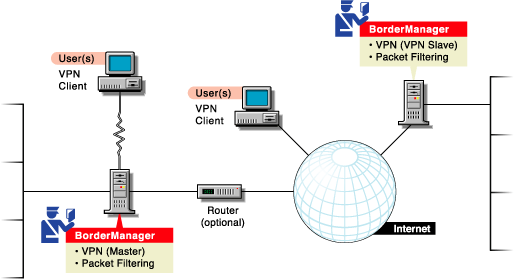Multiple VPNs

In this scenario, Acme Company has remote users and two remote offices that must have a secure connection to the company intranet. Acme has the following requirements:
The following Novell BorderManager 3.7 components are used to implement this scenario, as shown in the following figure:
NOTE: In this scenario, on-demand links cannot be used, and a VPN server cannot be located behind NAT.
Figure 27
Multiple VPNs
To implement multiple VPNs, Acme Company must perform the following general sequence of steps:
For more information and packet filtering configuration procedures, refer to the packet filtering online documentation.
For more information and configuration procedures, refer to Advanced Configuration of Virtual Private Networks.
For more information and configuration procedures, refer to Novell BorderManager 3.7 Installation Guide .
For more information and configuration procedures, refer to Managing Access Control.